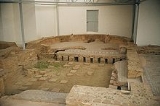
Hypocaust
Overview
Ancient Rome
Ancient Rome was a thriving civilization that grew on the Italian Peninsula as early as the 8th century BC. Located along the Mediterranean Sea and centered on the city of Rome, it expanded to one of the largest empires in the ancient world....
system of underfloor heating
Underfloor heating
Underfloor heating and cooling is a form of central heating and cooling which achieves indoor climate control for thermal comfort using conduction, radiation and convection...
, used to heat houses with hot air. The word derives from the Ancient Greek
Ancient Greek
Ancient Greek is the stage of the Greek language in the periods spanning the times c. 9th–6th centuries BC, , c. 5th–4th centuries BC , and the c. 3rd century BC – 6th century AD of ancient Greece and the ancient world; being predated in the 2nd millennium BC by Mycenaean Greek...
hypo meaning "under" and caust-, meaning "burnt". The Roman architect Vitruvius, writing about the end of the 1st century B.C., attributes their invention to Sergius Orata
Sergius Orata
Sergius Orata was a famed merchant and hydraulic engineer of the Roman Republic.Sergius was well-known by his contemporaries because of the breeding and commercialization of oysters, in which he can be considered a pioneer. Orata wanted to take advantage of Romans' taste for shellfish, so he...
, but this is not fully confirmed.
Hypocausts were used for heating hot baths (thermae
Thermae
In ancient Rome, thermae and balnea were facilities for bathing...
), houses and other buildings, whether public or private.
Unanswered Questions

